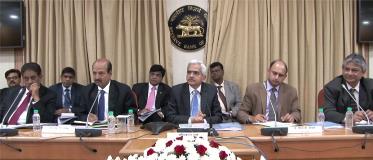RBI Monetary Policy: RBI cuts repo rate; maintains stance as neutral

Last Updated: 8th August 2022 - 06:41 pm
The Monetary Policy Committee (MPC) concluded its meeting on 04th April and announced a 25 basis point cut in the repo rates, largely along expected lines. This is the second consecutive rate cut from RBI under new chief Shaktikanta Das, after a 25 bps rate cut in February. The RBI opted for a mix of rate cuts to easy liquidity and address the issue of credit off-take. Here are the highlights.
-
Repo rate was cut by 25 basis points to 6% with a vote of 4:2 in favour of a rate cut by the MPC members. This also brings down the reverse repo rate and the bank rate proportionately by 25 bps each.
-
The MPC has maintained the stance as “Neutral”, keeping the option open to move either way if the situation warranted. MPC members voted in the ratio of 5:1.
-
On the liquidity front, the RBI will continue with its average monthly OMO (Open Market Operations) infusion of Rs40,000cr. This is now being accompanied by monthly dollar swap auctions to the tune of USD5 billion to address the liquidity shortfall.
Macro-economic background to the rate cut decision
Like in the previous monetary policy in February, the MPC has voted to continue focusing on growth impulses. This is considering the weak global growth; downgraded by IMF to the tune of 20 bps. In addition, domestic growth in GDP is likely to be pegged at 7% this year and 7.2% next year due to weak manufacturing growth. When RBI cut the policy rates by 25 bps in February, transmission was weak due to liquidity shortfall. That is the reason, the RBI has made sure to synchronize rate cuts with liquidity infusion. Apart from OMOs and dollar swaps, the RBI has also relaxed the High Quality Liquid Assets (HQLA) component in NDTL by 200 bps to make more liquidity available for lending. The RBI’s believes this synchronized approach should work better.
Policy support beyond rates and liquidity
Efficacy of monetary policy is not only judged by its approach to rates and liquidity but also how it handles the supportive regulatory framework.
-
Since most of the problems of liquidity arose from the NBFC and the HFC segment, the RBI has initiated the task of speedy securitization of such receivables. A robust secondary market could go a long way.
-
With NCLT doing a wonderful job in the last few months, the RBI has supplemented by setting up a task force to create a secondary market for corporate loans. This will ensure liquidity and exit for lenders reducing risk.
-
The controversial external benchmarking for floating rate loans to retail customers and SMEs announced in the December policy has been put off, for now, considering practical constraints involved.
The minutes of the policy discussions are expected to be published on 18th April, which could set the tone for the next policy post elections on 06th June.
- Flat ₹20 Brokerage
- Next-gen Trading
- Advance Charting
- Actionable Ideas
Trending on 5paisa
Indian Stock Market Related Articles
Disclaimer: Investment in securities market are subject to market risks, read all the related documents carefully before investing. For detailed disclaimer please Click here.
 5paisa Research Team
5paisa Research Team
 Sachin Gupta
Sachin Gupta




